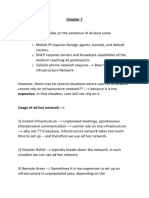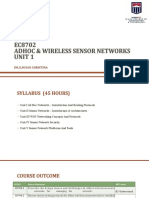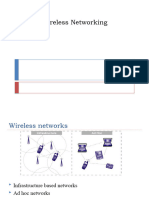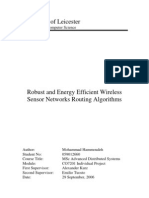0 ratings0% found this document useful (0 votes)
39 views21 pagesUNIT 5mobile Computing
Uploaded by
mishrashlok8Copyright
© © All Rights Reserved
We take content rights seriously. If you suspect this is your content, claim it here.
Available Formats
Download as PDF, TXT or read online on Scribd
0 ratings0% found this document useful (0 votes)
39 views21 pagesUNIT 5mobile Computing
Uploaded by
mishrashlok8Copyright
© © All Rights Reserved
We take content rights seriously. If you suspect this is your content, claim it here.
Available Formats
Download as PDF, TXT or read online on Scribd
You are on page 1/ 21
UNIT – 5
Ad Hoc Networks in Mobile Computing
Ad Hoc Networks are decentralized wireless networks where nodes communicate directly with each other
without relying on a fixed infrastructure, such as routers or access points. These networks are dynamic, self-
configuring, and can accommodate nodes that enter or leave the network at any time.
Key Characteristics of Ad Hoc Networks
1. Decentralization:
o Operate without a central administration or infrastructure, relying on the collective cooperation
of nodes.
2. Dynamic Topology:
o Nodes can move freely, resulting in a constantly changing network topology.
3. Multi-hop Communication:
o Nodes communicate through multiple hops, where intermediate nodes forward data to the
destination.
4. Self-Organization:
o Nodes join or leave the network at any time, and the network reconfigures itself to maintain
connectivity.
Types of Ad Hoc Networks
1. Mobile Ad Hoc Networks (MANETs):
o Comprised of mobile nodes that form a temporary network without relying on fixed
infrastructure. Commonly used in military operations, disaster recovery, and vehicular
networks.
2. Wireless Sensor Networks (WSNs):
o Consist of distributed sensors that monitor physical or environmental conditions and
communicate the collected data wirelessly. Used in environmental monitoring, health care, and
industrial automation.
3. Vehicular Ad Hoc Networks (VANETs):
o Formed by vehicles communicating with each other and with roadside infrastructure to
enhance traffic safety and efficiency. Support applications such as collision avoidance, traffic
management, and infotainment.
Challenges in Ad Hoc Networks
1. Routing:
o Efficiently finding and maintaining routes in a constantly changing network topology.
2. Security:
o Protecting the network from various security threats such as eavesdropping, spoofing, and
denial-of-service attacks.
3. Scalability:
o Managing network performance and resource allocation as the number of nodes increases.
4. Energy Efficiency:
o Conserving battery power in nodes, particularly in sensor networks, to prolong network
lifetime.
5. Quality of Service (QoS):
o Ensuring reliable delivery of data with specific performance guarantees such as bandwidth,
latency, and packet loss.
Routing Protocols in Ad Hoc Networks
1. Proactive Routing Protocols:
o Maintain up-to-date routing information to all nodes by periodically exchanging routing tables.
Optimized Link State Routing (OLSR): Utilizes link-state information to provide
optimal routes.
Destination-Sequenced Distance Vector (DSDV): Uses distance vector routing with
periodic updates.
2. Reactive Routing Protocols:
o Create routes only when needed by initiating a route discovery process.
Ad hoc On-Demand Distance Vector (AODV): Discovers routes on-demand and
maintains them as long as they are needed.
Dynamic Source Routing (DSR): Utilizes source routing, where the entire route is
included in the packet header.
3. Hybrid Routing Protocols:
o Combine features of both proactive and reactive protocols to balance the trade-offs.
Zone Routing Protocol (ZRP): Uses proactive routing within a local zone and reactive
routing for communication between zones.
Applications of Ad Hoc Networks
1. Military and Tactical Networks:
o Enable communication in battlefields where infrastructure is unavailable or unreliable.
2. Disaster Recovery and Emergency Services:
o Facilitate communication in areas where the infrastructure is damaged or nonexistent, such as
during natural disasters.
3. Vehicular Communication:
o Enhance road safety and traffic management through inter-vehicle communication and vehicle-
to-infrastructure communication.
4. Environmental Monitoring:
o Monitor and collect data on environmental conditions using wireless sensor networks deployed
in remote or hazardous areas.
5. Smart Homes and IoT:
o Connect various smart devices and sensors within a home or building to automate and control
home environments.
Security Solutions for Ad Hoc Networks
1. Authentication:
o Ensures that nodes are authenticated before joining the network and communicating.
Techniques include digital signatures and certificates.
2. Encryption:
o Protects data integrity and confidentiality through encryption methods such as symmetric and
asymmetric cryptography.
3. Intrusion Detection Systems (IDS):
o Monitor network traffic for signs of malicious activities and attacks, alerting administrators or
triggering automatic countermeasures.
4. Secure Routing Protocols:
o Enhance existing routing protocols with security features to protect against attacks like routing
misdirection and node impersonation.
Localization in Mobile and Ad Hoc Networks
Localization refers to the process of determining the physical position of a device within a network. In mobile
and ad hoc networks, accurate localization is essential for a variety of applications, including navigation,
tracking, geographic routing, and context-aware services.
Importance of Localization
1. Routing and Communication:
o Geographic routing protocols use location information to make routing decisions, improving
efficiency and reducing overhead.
2. Context-Aware Applications:
o Location-based services (LBS) provide personalized services based on the user’s current
location, such as local weather updates, navigation assistance, and nearby points of interest.
3. Resource Management:
o Optimizing resource allocation, such as power management, by considering the location of
nodes.
4. Safety and Security:
o Applications in disaster response and military operations require precise location information
for coordination and rescue operations.
5. Tracking and Monitoring:
o Asset tracking in logistics, patient monitoring in healthcare, and wildlife tracking in
environmental studies.
Techniques for Localization
1. GPS (Global Positioning System):
o Provides high accuracy but requires line of sight to satellites and consumes significant power,
making it less suitable for all environments and energy-constrained devices.
2. Triangulation and Trilateration:
o Triangulation: Determines location using the angles between known points.
o Trilateration: Uses the distances from known points (often derived from signal strengths).
3. Time-based Methods:
o Time of Arrival (ToA): Measures the travel time of a signal from the sender to the receiver.
o Time Difference of Arrival (TDoA): Uses the difference in arrival times of signals from
multiple transmitters to determine location.
4. Angle of Arrival (AoA):
o Determines the angle from which a signal arrives at a receiver, which can then be used to
estimate the location.
5. Received Signal Strength Indicator (RSSI):
o Estimates the distance between nodes based on the signal strength, which decreases with
distance. RSSI is commonly used in wireless sensor networks (WSNs).
6. Fingerprinting:
o Involves creating a database of signal characteristics (e.g., Wi-Fi, Bluetooth) at various known
locations. The current location is estimated by matching the observed signal characteristics with
the database.
Challenges in Localization
1. Accuracy:
o Achieving high accuracy in dense or cluttered environments, such as urban areas or indoors, can
be challenging due to signal multipath and attenuation.
2. Energy Consumption:
o Many localization techniques, such as GPS, consume significant power, which is a concern for
battery-powered devices.
3. Scalability:
o Ensuring that the localization system can scale efficiently with the number of nodes in large
networks.
4. Environmental Factors:
o Physical obstacles, weather conditions, and interference can affect the accuracy and reliability
of localization methods.
5. Security and Privacy:
o Protecting location information from unauthorized access and ensuring users’ privacy is crucial,
especially in sensitive applications.
Localization Algorithms
1. Centralized Algorithms:
o Centralized systems collect data from all nodes at a central location, where the localization
computation is performed. This approach can provide high accuracy but may suffer from single
points of failure and scalability issues.
2. Distributed Algorithms:
o Nodes collaborate to estimate their locations without relying on a central entity. This approach
improves scalability and resilience but may be more complex to implement.
3. Range-based Algorithms:
o Use measured distances or angles between nodes for localization. Examples include ToA, TDoA,
AoA, and RSSI-based methods.
4. Range-free Algorithms:
o Do not rely on distance measurements but use connectivity information, such as the number of
hops between nodes. Examples include DV-Hop and centroid-based algorithms.
Applications of Localization
1. Navigation and Tracking:
o GPS navigation, indoor navigation systems, and asset tracking.
2. Geographic Routing:
o Routing protocols in ad hoc networks that use geographic information to make forwarding
decisions, such as GPSR (Greedy Perimeter Stateless Routing).
3. Environmental Monitoring:
o Wireless sensor networks deployed for monitoring environmental parameters, where knowing
the exact location of each sensor is crucial for data analysis.
4. Emergency Response:
o Locating victims and responders in disaster scenarios to coordinate rescue operations
effectively.
5. Augmented Reality (AR):
o Enhancing user experiences in AR applications by providing accurate location information for
overlaying virtual objects on the real world.
MAC Issues and Routing Protocols in Mobile Ad Hoc Networks (MANETs)
MAC (Medium Access Control) Issues in Ad Hoc Networks
The MAC layer is responsible for coordinating access to the shared wireless medium. In ad hoc networks, this
layer faces unique challenges due to the decentralized nature and dynamic topology of the network.
Key MAC Issues:
1. Contention and Collision:
o With multiple nodes attempting to transmit simultaneously, collisions can occur, leading to data
loss and retransmissions.
2. Hidden Node Problem:
o Occurs when two nodes that cannot sense each other's transmissions (hidden from each other)
attempt to communicate with a common node, leading to collisions at the common node.
3. Exposed Node Problem:
o When a node refrains from transmitting to avoid interfering with an ongoing transmission by a
nearby node, even though it could have transmitted without causing a collision.
4. Dynamic Topology:
o Nodes frequently move, join, or leave the network, requiring the MAC protocol to adapt to
changing conditions.
5. Energy Efficiency:
o Mobile devices often have limited battery life, so the MAC protocol must minimize energy
consumption.
6. Quality of Service (QoS):
o Ensuring timely and reliable delivery of data packets, particularly for applications requiring
guaranteed bandwidth or low latency.
Common MAC Protocols for Ad Hoc Networks:
1. IEEE 802.11 DCF (Distributed Coordination Function):
o Uses CSMA/CA (Carrier Sense Multiple Access with Collision Avoidance) for managing access to
the medium.
o Relies on RTS/CTS (Request to Send/Clear to Send) handshake to mitigate the hidden node
problem.
2. MACA (Multiple Access with Collision Avoidance):
o Introduced the RTS/CTS mechanism to address the hidden node problem.
3. MACAW (MACA for Wireless):
o An enhancement of MACA, introducing additional control messages to improve performance.
4. S-MAC (Sensor-MAC):
o Designed for wireless sensor networks, it reduces energy consumption by using synchronized
sleep schedules.
5. TDMA-based Protocols:
o Allocate specific time slots to nodes for transmission, avoiding collisions and providing
deterministic access.
Routing Protocols in Ad Hoc Networks
Routing in ad hoc networks involves finding efficient paths for data packets between nodes without relying on
a fixed infrastructure. Routing protocols must cope with the dynamic and decentralized nature of these
networks.
Categories of Routing Protocols:
1. Proactive (Table-Driven) Protocols:
o Maintain up-to-date routing information to all nodes by periodically exchanging routing tables.
Examples:
o Optimized Link State Routing (OLSR): Utilizes link-state information to provide optimal
routes. Uses hello and topology control (TC) messages to discover and disseminate link-state
information.
o Destination-Sequenced Distance Vector (DSDV): An extension of the Bellman-Ford algorithm
that maintains consistent routing tables with periodic updates and sequence numbers to avoid
routing loops.
2. Reactive (On-Demand) Protocols:
o Create routes only when needed by initiating a route discovery process.
Examples:
o Ad hoc On-Demand Distance Vector (AODV): Discovers routes on-demand and maintains
them as long as they are needed. Uses route request (RREQ) and route reply (RREP) messages.
o Dynamic Source Routing (DSR): Utilizes source routing, where the entire route is included in
the packet header. Routes are discovered on-demand and maintained in a route cache.
3. Hybrid Protocols:
o Combine features of both proactive and reactive protocols to balance the trade-offs.
Examples:
o Zone Routing Protocol (ZRP): Uses proactive routing within a local zone and reactive routing
for communication between zones. Reduces the control overhead by limiting the proactive
scope to a local neighborhood.
4. Geographic Routing Protocols:
o Use location information to make forwarding decisions, reducing the need for route discovery
and maintenance.
Examples:
o Greedy Perimeter Stateless Routing (GPSR): Forwards packets greedily towards the
destination based on location information. Uses perimeter routing to recover from local minima.
Challenges in Routing:
1. Mobility:
o Frequent changes in topology due to node mobility require the routing protocol to quickly adapt
to new routes.
2. Scalability:
o The protocol must efficiently handle a large number of nodes without excessive overhead.
3. Energy Efficiency:
o Minimizing energy consumption to extend the battery life of mobile nodes.
4. QoS Requirements:
o Ensuring reliable and timely delivery of packets, particularly for applications requiring
guaranteed performance.
5. Security:
o Protecting the network from various attacks such as eavesdropping, spoofing, and denial-of-
service attacks.
Global State Routing (GSR)
Global State Routing (GSR) is a proactive (table-driven) routing protocol designed for mobile ad hoc networks
(MANETs). Unlike reactive protocols that discover routes on demand, GSR continuously maintains up-to-date
routing information to all nodes within the network. This continuous maintenance helps in ensuring quick
route availability but can incur overhead due to periodic updates.
Key Features of Global State Routing
1. Proactive Routing:
o GSR maintains consistent and up-to-date routing tables by exchanging routing information
periodically. Each node keeps a complete view of the network topology.
2. Global Topology Information:
o Nodes maintain information about the entire network topology, ensuring that they can compute
optimal routes to any destination within the network.
3. Link-State Information:
o GSR is based on the link-state routing principle. Nodes periodically broadcast link-state updates
to ensure that all nodes have a consistent view of the network.
4. Scalability:
o Designed to handle larger networks by managing the routing information efficiently and
reducing the frequency of updates when changes in topology are less frequent.
How Global State Routing Works
1. Routing Table Maintenance:
o Each node maintains a routing table with entries for all other nodes in the network. The table
includes information about the next hop, the distance to the destination, and the path cost.
2. Periodic Updates:
o Nodes periodically exchange routing updates with their neighbors. These updates contain
information about the state of their links to other nodes.
3. Link-State Advertisements (LSAs):
o Nodes generate LSAs containing information about their direct links and disseminate these
advertisements throughout the network.
4. Path Computation:
o Using the received link-state information, each node computes the shortest path to all other
nodes using algorithms like Dijkstra’s shortest path algorithm.
5. Update Propagation:
o When a node detects a change in its local topology (e.g., a link break or a new link), it updates its
link-state information and propagates this change to the entire network.
Advantages of GSR
1. Immediate Route Availability:
o Since routes are precomputed and maintained continuously, they are immediately available
when needed, reducing the delay compared to reactive protocols.
2. Consistent View of Network Topology:
o Nodes have a complete and consistent view of the network, which helps in making optimal
routing decisions.
3. Efficient Path Computation:
o The use of link-state information allows for efficient computation of shortest paths, leading to
optimal routing.
Disadvantages of GSR
1. High Overhead:
o Maintaining up-to-date routing information for all nodes involves significant control message
overhead, particularly in highly dynamic networks where the topology changes frequently.
2. Scalability Concerns:
o As the network size grows, the amount of control traffic and the storage requirements for
routing tables increase, potentially limiting scalability.
3. Resource Intensive:
o GSR can be resource-intensive in terms of memory and processing power, as each node needs to
store and process a large amount of routing information.
Applications of GSR
GSR is suitable for scenarios where the network topology does not change frequently, and there is a need for
immediate route availability. It is often used in:
1. Military Networks:
o Where stable and immediate communication routes are critical.
2. Disaster Recovery:
o Providing reliable communication in areas affected by natural disasters where infrastructure is
damaged.
3. Static or Low Mobility Networks:
o Such as wireless sensor networks in industrial or environmental monitoring where nodes are
mostly stationary or have limited mobility.
Global State Routing (GSR)
Global State Routing (GSR) is a proactive (table-driven) routing protocol designed for mobile ad hoc networks
(MANETs). Unlike reactive protocols that discover routes on demand, GSR continuously maintains up-to-date
routing information to all nodes within the network. This continuous maintenance helps in ensuring quick
route availability but can incur overhead due to periodic updates.
Key Features of Global State Routing
1. Proactive Routing:
o GSR maintains consistent and up-to-date routing tables by exchanging routing information
periodically. Each node keeps a complete view of the network topology.
2. Global Topology Information:
o Nodes maintain information about the entire network topology, ensuring that they can compute
optimal routes to any destination within the network.
3. Link-State Information:
o GSR is based on the link-state routing principle. Nodes periodically broadcast link-state updates
to ensure that all nodes have a consistent view of the network.
4. Scalability:
o Designed to handle larger networks by managing the routing information efficiently and
reducing the frequency of updates when changes in topology are less frequent.
How Global State Routing Works
1. Routing Table Maintenance:
o Each node maintains a routing table with entries for all other nodes in the network. The table
includes information about the next hop, the distance to the destination, and the path cost.
2. Periodic Updates:
o Nodes periodically exchange routing updates with their neighbors. These updates contain
information about the state of their links to other nodes.
3. Link-State Advertisements (LSAs):
o Nodes generate LSAs containing information about their direct links and disseminate these
advertisements throughout the network.
4. Path Computation:
o Using the received link-state information, each node computes the shortest path to all other
nodes using algorithms like Dijkstra’s shortest path algorithm.
5. Update Propagation:
o When a node detects a change in its local topology (e.g., a link break or a new link), it updates its
link-state information and propagates this change to the entire network.
Advantages of GSR
1. Immediate Route Availability:
o Since routes are precomputed and maintained continuously, they are immediately available
when needed, reducing the delay compared to reactive protocols.
2. Consistent View of Network Topology:
o Nodes have a complete and consistent view of the network, which helps in making optimal
routing decisions.
3. Efficient Path Computation:
o The use of link-state information allows for efficient computation of shortest paths, leading to
optimal routing.
Disadvantages of GSR
1. High Overhead:
o Maintaining up-to-date routing information for all nodes involves significant control message
overhead, particularly in highly dynamic networks where the topology changes frequently.
2. Scalability Concerns:
o As the network size grows, the amount of control traffic and the storage requirements for
routing tables increase, potentially limiting scalability.
3. Resource Intensive:
o GSR can be resource-intensive in terms of memory and processing power, as each node needs to
store and process a large amount of routing information.
Applications of GSR
GSR is suitable for scenarios where the network topology does not change frequently, and there is a need for
immediate route availability. It is often used in:
1. Military Networks:
o Where stable and immediate communication routes are critical.
2. Disaster Recovery:
o Providing reliable communication in areas affected by natural disasters where infrastructure is
damaged.
3. Static or Low Mobility Networks:
o Such as wireless sensor networks in industrial or environmental monitoring where nodes are
mostly stationary or have limited mobility.
Destination-Sequenced Distance-Vector (DSDV) Routing
Destination-Sequenced Distance-Vector (DSDV) routing is a proactive (table-driven) routing protocol
specifically designed for mobile ad hoc networks (MANETs). It extends the classical Bellman-Ford routing
algorithm by incorporating sequence numbers to avoid routing loops and ensure the freshness of routing
information.
Key Features of DSDDV
1. Proactive Routing:
o DSDV maintains up-to-date routes to all destinations at all times. Each node in the network
maintains a routing table containing the shortest path to every other node.
2. Sequence Numbers:
o Each route entry is tagged with a sequence number. These sequence numbers are generated by
the destination node to ensure that the routes are loop-free and to distinguish stale routes from
the fresh ones.
3. Periodic Updates:
o Routing tables are periodically updated and broadcasted to neighboring nodes. This helps in
maintaining the consistency of the routing information throughout the network.
4. Triggered Updates:
o In addition to periodic updates, DSDV also employs triggered updates. These are sent
immediately when a significant change in the topology is detected, such as a broken link.
How DSDV Works
1. Routing Table Maintenance:
o Each node maintains a routing table with entries for all other nodes in the network. Each entry
contains:
The destination node.
The next hop towards the destination.
The number of hops to reach the destination.
The sequence number of the destination.
A metric to indicate the route's freshness.
2. Sequence Numbers:
o Sequence numbers are used to determine the freshness of a route. A higher sequence number
indicates a fresher route. If two routes have the same sequence number, the one with the lower
hop count is preferred.
3. Periodic Updates:
o Nodes periodically transmit their routing tables to their immediate neighbors. These updates
contain the entire routing table or a portion of it, depending on the network's size and the
protocol's configuration.
4. Triggered Updates:
o When a node detects a significant change in the network topology (e.g., a link break or the
addition of a new node), it generates a triggered update. This ensures that the routing tables
converge quickly to the new topology.
5. Route Selection:
o Upon receiving an update, a node compares the sequence numbers of the received routes with
the ones in its routing table. If the received sequence number is higher, or if the sequence
number is the same but the hop count is lower, the node updates its routing table.
Advantages of DSDV
1. Loop-Free Routes:
o The use of sequence numbers ensures that the routes are loop-free, which is critical in mobile
networks where loops can lead to inefficiency and network congestion.
2. Immediate Route Availability:
o Since routes are maintained proactively, they are available immediately when needed, reducing
the route discovery delay experienced in reactive protocols.
3. Consistency and Stability:
o Periodic and triggered updates help maintain a consistent view of the network topology, which
enhances the stability of the routing tables.
Disadvantages of DSDV
1. High Overhead:
o Maintaining up-to-date routing information for all nodes involves significant control message
overhead, especially in large or highly dynamic networks.
2. Scalability Issues:
o As the network size increases, the overhead associated with maintaining and broadcasting
routing tables grows, which can limit the scalability of the protocol.
3. Resource Consumption:
o The periodic updates and large routing tables can consume substantial bandwidth and
processing power, which may be a concern for resource-constrained nodes.
Applications of DSDV
DSDV is suitable for scenarios where the network topology is relatively stable and the overhead of maintaining
up-to-date routing information is justified by the need for immediate route availability. It is often used in:
1. Small to Medium-Sized Networks:
o Networks where the size and the rate of topology change are moderate, making the overhead
manageable.
2. Military Networks:
o Where consistent and immediate route availability is critical for mission-critical
communications.
3. Emergency and Disaster Recovery Networks:
o Providing reliable communication in scenarios where infrastructure is unavailable or has been
disrupted.
Dynamic Source Routing (DSR)
Dynamic Source Routing (DSR) is a reactive (on-demand) routing protocol designed for mobile ad hoc
networks (MANETs). Unlike proactive protocols, DSR does not maintain a complete and up-to-date routing
table. Instead, it discovers routes only when needed, reducing overhead in highly dynamic networks.
Key Features of DSR
1. On-Demand Route Discovery:
o Routes are discovered only when a node has data to send to another node for which it does not
have a route.
2. Source Routing:
o The entire route to the destination is included in the packet header. Intermediate nodes forward
the packet based on this information, without needing their routing tables.
3. Route Caching:
o Nodes cache routes that they learn during the route discovery process. This helps in reducing
the overhead of future route discoveries.
4. Route Maintenance:
o Nodes monitor the operation of the route while it is in use and can detect if the route has
become invalid.
How DSR Works
1. Route Discovery:
o When a node (source) needs to send a packet to another node (destination) for which it does
not have a route, it initiates a route discovery process by broadcasting a Route Request (RREQ)
packet.
o The RREQ packet is flooded through the network. Each node that receives the RREQ adds its
address to the route record in the packet and then forwards it.
o When the RREQ reaches the destination or an intermediate node with a route to the destination,
it sends a Route Reply (RREP) back to the source. The RREP packet travels back along the
reverse path recorded in the RREQ.
2. Route Caching:
o Nodes store the routes they learn during the route discovery process in a route cache. This
helps in quickly finding routes for future packets without initiating a new route discovery.
3. Route Maintenance:
o Nodes monitor the links used in active routes. If a link break is detected (e.g., by the absence of
an acknowledgment), the detecting node sends a Route Error (RERR) packet back to the source
node, indicating the broken link.
o The source node can then use another route from its cache or initiate a new route discovery if
no alternative route is available.
Advantages of DSR
1. Reduced Overhead:
o DSR reduces the overhead associated with maintaining up-to-date routing information for all
possible destinations, as it only discovers routes on demand.
2. Flexibility:
o The protocol adapts quickly to changes in the network topology by discovering new routes as
needed.
3. Route Caching:
o Route caching can significantly improve the efficiency of the protocol by reducing the frequency
of route discoveries.
Disadvantages of DSR
1. Route Discovery Latency:
o The process of discovering routes can introduce latency, particularly in large networks or when
the route cache does not have the required route.
2. Packet Header Overhead:
o Source routing requires that the entire route be included in the packet header, which can
increase the size of the packets and reduce the effective bandwidth.
3. Scalability Issues:
o In large networks, the overhead associated with route discoveries and the size of the route
caches can become significant, affecting the protocol’s scalability.
4. Routing Loops:
o In the absence of proper loop prevention mechanisms, the protocol may experience temporary
routing loops during the route discovery process.
Applications of DSR
DSR is suitable for ad hoc networks where the topology changes frequently and the overhead of maintaining
complete routing tables is not justified. It is often used in:
1. Mobile Networks with High Mobility:
o Environments where nodes frequently move, such as vehicular ad hoc networks (VANETs) or
networks for mobile devices.
2. Disaster Recovery and Emergency Services:
o Scenarios where infrastructure is unavailable or disrupted, and rapid deployment and
adaptability are critical.
3. Military Applications:
o Situations where the network topology is highly dynamic and routes need to be discovered
quickly as needed.
Ad hoc On-Demand Distance Vector (AODV) Routing
Ad hoc On-Demand Distance Vector (AODV) is a reactive (on-demand) routing protocol designed for mobile ad
hoc networks (MANETs). Unlike proactive routing protocols, AODV creates routes only when needed, reducing
the overhead of maintaining comprehensive routing information.
Key Features of AODV
1. On-Demand Route Discovery:
o Routes are established only when a node needs to communicate with another node for which it
does not have a route.
2. Distance Vector Routing:
o AODV uses distance vector routing principles, maintaining the next-hop information for each
destination in the routing table, along with a distance metric (hop count).
3. Sequence Numbers:
o Each route entry is associated with a sequence number, ensuring the freshness of the routing
information and preventing routing loops.
4. Route Maintenance:
o Routes are maintained as long as they are needed by the source node. When a route is no longer
required, it is deleted from the routing table.
How AODV Works
1. Route Discovery:
o When a source node needs a route to a destination and does not have one, it initiates a route
discovery process by broadcasting a Route Request (RREQ) packet to its neighbors.
o The RREQ packet contains the following information:
Source address
Destination address
Source sequence number
Destination sequence number
Broadcast ID
o Intermediate nodes forward the RREQ, adding their own address to the reverse path in the
packet. If they have a valid route to the destination, they respond with a Route Reply (RREP).
o The destination node, upon receiving the RREQ, sends a RREP back to the source node along the
reverse path established by the RREQ.
2. Route Reply (RREP):
o The RREP packet is unicast back to the source node, containing:
Source address
Destination address
Destination sequence number
Hop count
o Intermediate nodes update their routing tables with the route to the destination as they forward
the RREP.
3. Route Maintenance:
o Nodes monitor the links in active routes. If a link break is detected, the node upstream of the
break generates a Route Error (RERR) packet.
o The RERR packet is propagated back to the source node, which can then initiate a new route
discovery if the route is still needed.
4. Sequence Numbers:
o Sequence numbers are used to ensure the freshness of routes and to prevent routing loops. A
higher sequence number indicates a fresher route.
Advantages of AODV
1. Reduced Overhead:
o Routes are established on-demand, minimizing the overhead associated with maintaining
complete routing tables at all times.
2. Loop-Free Routes:
o The use of sequence numbers ensures that routes are loop-free, enhancing the reliability and
efficiency of the routing protocol.
3. Adaptability:
o AODV quickly adapts to changing network conditions, making it suitable for highly dynamic
environments.
Disadvantages of AODV
1. Route Discovery Latency:
o The process of discovering routes can introduce latency, particularly in large networks or when
the route cache does not have the required route.
2. Control Overhead:
o While AODV reduces overhead compared to proactive protocols, the flooding of RREQ packets
can still cause significant control overhead in large or highly mobile networks.
3. Scalability Issues:
o In very large networks, the frequency of route discoveries and the control message overhead
can impact the scalability of the protocol.
Applications of AODV
AODV is suitable for a variety of applications where the network topology is dynamic and maintaining up-to-
date routing information at all times is impractical. Common applications include:
1. Military Networks:
o Highly dynamic environments where quick adaptation to changing topologies is essential.
2. Disaster Recovery and Emergency Services:
o Scenarios where the infrastructure is unavailable or disrupted, requiring rapid deployment and
adaptability.
3. Vehicular Ad hoc Networks (VANETs):
o Networks of vehicles where the topology changes frequently as vehicles move.
4. Mobile Sensor Networks:
o Networks of mobile sensors that need to dynamically establish routes as they move.
Temporary Ordered Routing Algorithm (TORA)
The Temporary Ordered Routing Algorithm (TORA) is a highly adaptive, distributed routing protocol designed
specifically for mobile ad hoc networks (MANETs). It is particularly well-suited for environments where
network topology changes frequently, as it aims to minimize reaction to topological changes.
Key Features of TORA
1. Adaptive and Distributed:
o TORA is designed to react quickly to changes in network topology, maintaining routes in a
decentralized manner.
2. Multiple Routes:
o TORA can maintain multiple routes to a destination, improving fault tolerance and reducing the
likelihood of network partitions.
3. Loop-Free Routes:
o The protocol ensures that the routes are loop-free by maintaining a directed acyclic graph
(DAG) rooted at the destination.
4. Localized Reactions:
o Topological changes are handled locally, reducing the need for global routing table updates and
minimizing control message overhead.
5. Three Main Functions:
o TORA consists of three main functions: route creation, route maintenance, and route erasure.
How TORA Works
1. Route Creation:
o The route creation process establishes a directed acyclic graph (DAG) rooted at the destination.
o A node needing a route to a destination broadcasts a Query (QRY) packet. This packet
propagates through the network until it reaches the destination or a node with a route to the
destination.
o The recipient node of the QRY packet responds with an Update (UPD) packet, which sets the
height of the node and establishes a link direction based on the heights, effectively creating the
DAG.
2. Route Maintenance:
o TORA maintains routes using a concept of heights to reflect the link states. The height of a node
is a tuple consisting of several parameters, ensuring unique identification of link states.
o When a node detects a link failure, it adjusts its height and propagates this change to its
neighbors, triggering them to adjust their heights as well. This propagation continues until the
DAG is reestablished, ensuring a loop-free and consistent routing structure.
3. Route Erasure:
o When a route is no longer needed or a node determines that it is no longer able to reach the
destination, it initiates a route erasure process.
o A Clear (CLR) packet is propagated through the network to erase the invalid routes, ensuring
that all nodes remove the stale route entries.
Advantages of TORA
1. Adaptability:
o TORA adapts quickly to changes in network topology, making it suitable for highly dynamic
environments.
2. Multiple Routes:
o By maintaining multiple routes, TORA enhances reliability and fault tolerance. If one route fails,
another can be used without the need for immediate route discovery.
3. Localized Reaction:
o The protocol handles topological changes locally, reducing the overall control message
overhead and improving scalability.
4. Loop-Free Operation:
o The use of directed acyclic graphs ensures that the routes are loop-free, preventing routing
loops and improving network efficiency.
Disadvantages of TORA
1. Complexity:
o The protocol's reliance on multiple parameters for height calculation and the maintenance of
DAGs can introduce complexity, which may affect performance in some scenarios.
2. Control Message Overhead:
o While TORA aims to minimize global control message overhead, the localized reaction to
topology changes can still result in significant control message propagation in certain situations.
3. Potential for Oscillations:
o Frequent topology changes can lead to oscillations in the route maintenance process, potentially
causing temporary route instability.
Applications of TORA
TORA is suitable for applications where the network topology is highly dynamic, and rapid adaptation to
changes is essential. Common applications include:
1. Military Networks:
o Environments with highly mobile nodes, where quick adaptation to changing network
conditions is critical.
2. Disaster Recovery and Emergency Services:
o Scenarios requiring rapid deployment and adaptation to changing conditions without reliance
on a fixed infrastructure.
3. Vehicular Ad hoc Networks (VANETs):
o Networks of moving vehicles, where the topology changes frequently and reliable
communication is necessary.
4. Sensor Networks:
o Applications involving mobile sensors that need to maintain connectivity despite frequent
changes in the network topology.
Quality of Service (QoS) in Ad Hoc Networks
Quality of Service (QoS) in ad hoc networks refers to the ability to provide different priority levels and
guarantee performance metrics such as bandwidth, latency, jitter, and packet loss rate for various types of
traffic. Ensuring QoS in ad hoc networks is challenging due to the dynamic and decentralized nature of these
networks, frequent topology changes, and the limited resources of mobile nodes.
Key QoS Metrics
1. Bandwidth: The maximum rate of data transfer across a network path.
2. Latency: The time it takes for a data packet to travel from the source to the destination.
3. Jitter: The variation in time delay in packet delivery.
4. Packet Loss: The number of packets that fail to reach their destination.
5. Throughput: The actual rate of successful data transfer.
QoS Mechanisms in Ad Hoc Networks
1. QoS Routing Protocols:
o QoS-aware routing protocols discover and maintain routes that meet the QoS requirements of
the traffic. Examples include:
Ad hoc QoS On-Demand Routing (AQOR): Incorporates QoS parameters in the route
discovery process.
QoS-Aware Optimized Link State Routing (QOLSR): An extension of the OLSR
protocol that includes QoS metrics.
2. Resource Reservation:
o Mechanisms for reserving bandwidth or other resources along the path of a data flow to ensure
that QoS requirements are met.
o Resource Reservation Protocol (RSVP) can be adapted for use in ad hoc networks to reserve
resources dynamically.
3. Admission Control:
o Decides whether a new flow can be admitted to the network based on the current resource
availability and the QoS requirements of existing flows.
o Ensures that admitting a new flow does not degrade the QoS of existing flows.
4. MAC Layer Enhancements:
o Modifications to the Medium Access Control (MAC) layer to support QoS, such as priority
queuing, traffic differentiation, and fair scheduling.
o IEEE 802.11e: An enhancement of the IEEE 802.11 standard to provide QoS support by
introducing traffic categories and prioritization.
5. Cross-Layer Design:
o Involves the exchange of information between different layers (e.g., application, network, MAC,
and physical layers) to make more informed QoS decisions.
o Helps in adapting to the dynamic conditions of ad hoc networks by providing a holistic view of
network status and resource availability.
Applications of QoS in Ad Hoc Networks
1. Real-Time Multimedia Communication:
o Applications such as video conferencing, VoIP, and live streaming require stringent QoS
guarantees to ensure smooth and uninterrupted service.
2. Emergency and Disaster Recovery:
o In emergency scenarios, reliable and prioritized communication is essential for coordinating
rescue operations and ensuring safety.
3. Military Operations:
o Military applications require secure and reliable communication with QoS support to handle
real-time data, such as surveillance video and mission-critical commands.
4. Telemedicine:
o Remote medical consultations and surgeries need high QoS to ensure clear video and audio
transmission, which are critical for accurate diagnosis and treatment.
5. Vehicular Ad Hoc Networks (VANETs):
o Applications such as collision avoidance systems, traffic management, and infotainment services
in VANETs rely on QoS to provide timely and reliable communication.
6. Smart Grid and Utility Networks:
o In smart grid applications, QoS ensures the timely delivery of monitoring and control messages,
which are essential for the efficient operation of the grid.
Challenges in Providing QoS in Ad Hoc Networks
1. Dynamic Topology:
o Frequent changes in network topology due to node mobility make it difficult to maintain stable
routes and consistent QoS guarantees.
2. Limited Resources:
o Nodes in ad hoc networks often have limited power, bandwidth, and processing capabilities,
which can constrain the ability to support QoS.
3. Interference and Channel Conditions:
o Wireless communication is prone to interference, multipath fading, and varying channel
conditions, which can affect QoS.
4. Scalability:
o Ensuring QoS in large-scale ad hoc networks can be challenging due to the increased complexity
of maintaining resource reservations and QoS-aware routes.
5. Security:
o Providing QoS while ensuring the security and integrity of data is a significant challenge,
especially in hostile environments like military networks.
You might also like
- Comprehensive Study For Localization Techniques in MANET and VANETNo ratings yetComprehensive Study For Localization Techniques in MANET and VANET4 pages
- Recent Applications and Development in Wireless Ad Hoc and Sensor NetworkNo ratings yetRecent Applications and Development in Wireless Ad Hoc and Sensor Network17 pages
- Wireless Ad Hoc and Sensor Networks: Section FundingNo ratings yetWireless Ad Hoc and Sensor Networks: Section Funding4 pages
- MANET Routing Protocols for Military UseNo ratings yetMANET Routing Protocols for Military Use11 pages
- Chapter 8 Mobile AdHoc Networks, Protocols and Security ClassNo ratings yetChapter 8 Mobile AdHoc Networks, Protocols and Security Class46 pages
- Comparison of Routing Protocols For Ad H PDFNo ratings yetComparison of Routing Protocols For Ad H PDF6 pages
- Sdodv: A Smart and Adaptive On Demand Distance Vector Routing Protocol For ManetsNo ratings yetSdodv: A Smart and Adaptive On Demand Distance Vector Routing Protocol For Manets24 pages
- An Overview of Secure Routing Protocols Mobile Adhoc NetworkNo ratings yetAn Overview of Secure Routing Protocols Mobile Adhoc Network5 pages
- Submitted To Submitted by Submitted by MR - Hemant Kumar Jyotendra Sharma (Ec-A Iii Yr)No ratings yetSubmitted To Submitted by Submitted by MR - Hemant Kumar Jyotendra Sharma (Ec-A Iii Yr)17 pages
- Researching and Implementing Internet of Things Data Analysis SchemesNo ratings yetResearching and Implementing Internet of Things Data Analysis Schemes9 pages
- Energy Consumption Using Hybrid Daodv (Dsdv-Aodv) Protocol in ManetNo ratings yetEnergy Consumption Using Hybrid Daodv (Dsdv-Aodv) Protocol in Manet48 pages
- Description:: Dynamic Destination-Sequenced Distance-Vector Routing ProtocolNo ratings yetDescription:: Dynamic Destination-Sequenced Distance-Vector Routing Protocol6 pages
- Robust and Energy Efficient Wireless Sensor Networks Routing Algorithms0% (1)Robust and Energy Efficient Wireless Sensor Networks Routing Algorithms73 pages
- Routing Techniques in Wireless Sensor NetworksNo ratings yetRouting Techniques in Wireless Sensor Networks107 pages
- 557 Số Điện Thoại - Khách Vip Quận Gò VấpNo ratings yet557 Số Điện Thoại - Khách Vip Quận Gò Vấp24 pages
- Circuit Card Reference Avaya Communication Server 1000: Release 7.6 NN43001-311 Issue 06.01 March 2013No ratings yetCircuit Card Reference Avaya Communication Server 1000: Release 7.6 NN43001-311 Issue 06.01 March 2013686 pages
- ACM ICPC Report March 1 1 - Competencias en Jamaica100% (1)ACM ICPC Report March 1 1 - Competencias en Jamaica5 pages
- Blockchain Based e Voting System ReportNo ratings yetBlockchain Based e Voting System Report61 pages
- .Trashed 1742732429 Java Packages GeeksforGeeksNo ratings yet.Trashed 1742732429 Java Packages GeeksforGeeks10 pages
- Programs Using System Calls EX - NO: 2a Fork System Call Date: AIMNo ratings yetPrograms Using System Calls EX - NO: 2a Fork System Call Date: AIM4 pages
- QwikSkills Azure Cloud Training - CurriculumNo ratings yetQwikSkills Azure Cloud Training - Curriculum24 pages
- 1-DatAdvantage Basic Installation Lab Guide 8.6No ratings yet1-DatAdvantage Basic Installation Lab Guide 8.6146 pages
- Software Engineering Lab 02 Prepared by Dang Minh ThangNo ratings yetSoftware Engineering Lab 02 Prepared by Dang Minh Thang16 pages
- SEN Unit 1. CM Software Development ProcessNo ratings yetSEN Unit 1. CM Software Development Process37 pages
- Answer:: Answer: The Two Models of Interprocess Communication Are Message-Passing Model andNo ratings yetAnswer:: Answer: The Two Models of Interprocess Communication Are Message-Passing Model and7 pages




























































































